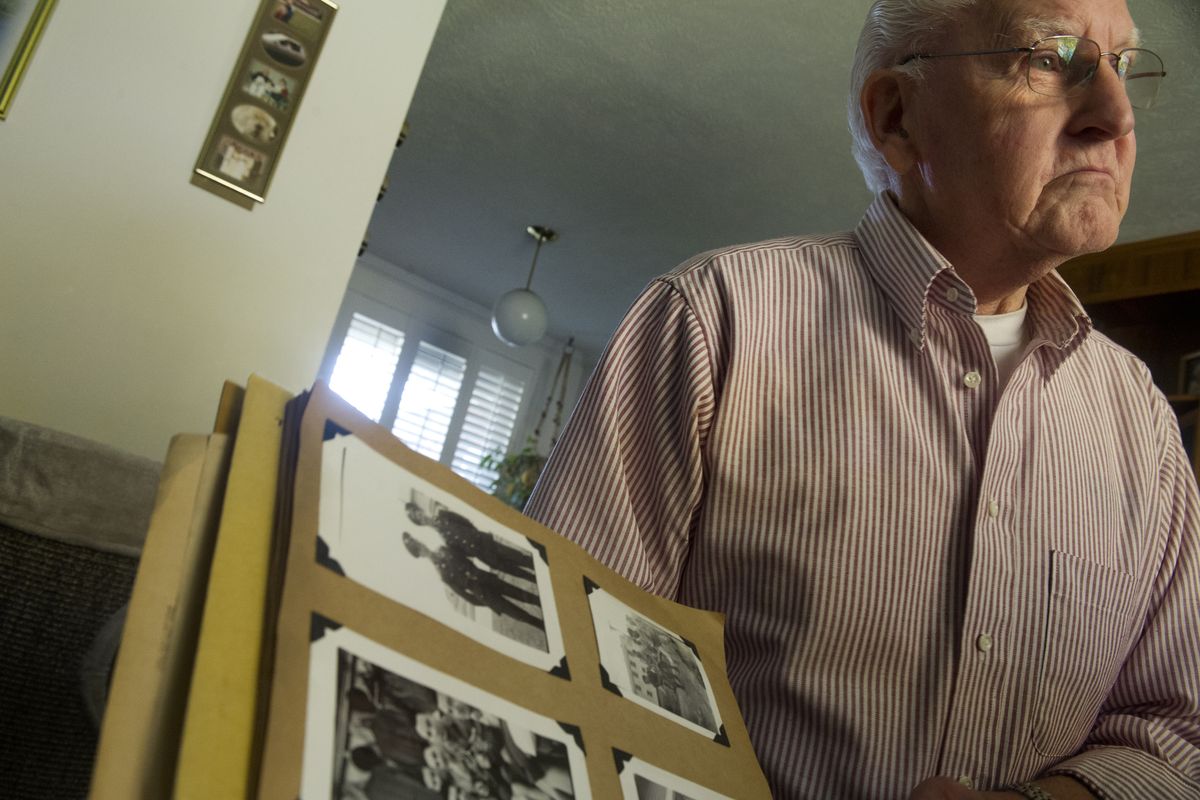‘Bloody Hundredth’ WWII bombardier’s life story compiled by brother

Bill Heath was barely 21 back in the fall of 1943 when he arrived at Thorpe Abbots airfield in southeastern England, a second lieutenant reporting for duty as a B-17 bombardier.
It was the early days of the U.S. Army’s controversial daylight bombing campaign over Nazi-occupied Europe. The Newport, Wash., kid was among the fresh crews sent to help replenish the rapidly depleting ranks of the 100th Bombardment Group, which took such heavy losses it became known as “The Bloody Hundredth.”
Five weeks later, Heath and his fellow crew members were dead. It was their seventh mission.
“They kind of knew what they were getting into when they found out they’d been assigned to the 100th,” said Ken Heath, who was 13 going on 14 when his older brother was killed Oct. 8, 1943, but wouldn’t learn until decades later the historical significance of his wartime service. “The pilot of Bill’s crew … wrote in his journal after learning where they were headed, ‘We really stepped into something.’ ”
Their B-17, nicknamed the “Marie Helena,” exploded and crashed after being hit in midair by a damaged Nazi fighter careening into the thick swarm of Flying Fortresses lining up for their bombing run on the war factories of Bremen, Germany. Heavy U.S. losses that day also included the famed “Piccadilly Lily,” the B-17 memorialized by Hollywood in the Gregory Peck classic “Twelve O’Clock High.”
The story of 2nd Lt. William Heath, and the tragically short history of the Marie Helena, has been carefully researched and compiled over the past decade by his younger brother, who lives in Spokane Valley and has endeavored to keep Bill’s memory alive.
Although lacking in the kind of detail that war stories carried back by survivors often contain, the impressive collection of flight logs, crew journal entries, personal letters and even Dutch police reports he has assembled paints a hauntingly complete picture of a bomber crew’s dedication to duty in the bloodiest months before long-range fighter escorts became widely available.
It’s the only way to tell the stories of the people who didn’t make it back: The people like Bill Heath who dutifully crawled into their Flying Fortresses for each new mission realizing the odds were against them returning to the airfield that day, but knowing it was the only way to begin breaking the Nazi war machine. The group lost 229 bombers and 768 men in less than two years.
“What Ken has done is a real lesson in brotherly love,” said Michael P. Faley, a historian in Southern California who maintains a website dedicated to preserving the 100th Bomb Group’s contributions during World War II. “The sacrifices these guys made for us, for all of us and the freedoms we enjoy, we should all be doing what Ken has done to make sure their stories don’t get lost.”
The Bloody Hundredth website reads like a cross between a historical archive and funeral roll call for young men cut down in the war’s pioneering daylight bombing strategy. The site includes numerous archive photos, flight logs and personal memoirs. Ken Heath’s efforts to chronicle his brother’s final days are included as well.
Faley said Bill Heath arrived at Thorpe Abbotts at a time when B-17 crews had just a one-in-three chance of returning from bombing raids. Those odds eventually improved as squadrons of long-range P-51 Mustang fighters arrived and were able to sweep the skies and engage Luftwaffe fighters ahead of the bombers as well as escort them back.
But in the fall of 1943, when Heath and the Marie Helena were pressed into service, bomber crews were left to fend largely for themselves as Luftwaffe fighters chewed the columns of B-17s to pieces.
Ken Heath embarked on his brotherly journey after retiring from Kaiser Aluminum. He’d happened across a book about the B-17 bomber, and while flipping through it, he landed on an archive photo of a squadron of Flying Fortresses en route to Bremen on Sept. 8, 1943. He recognized the date and the mission as the one that took his brother. For most of his life, that’s about all Ken Heath knew about Bill’s wartime service.
He contacted his siblings and began compiling everything they could remember about Bill’s time in the military. Where he trained. The unit he served in.
As the details began to build, Ken Heath and his wife, Carol, traveled to Europe in 2005 to visit his brother’s grave and the Dutch village where the fiery debris of his bomber crashed near the German border. The farmer who now owns the fields gave the couple a flight instrument and some thick plastic from the nose cone that he’d dug out of the soil years earlier. Both items were from portions of the plane where the bombardier would have been located.
The journey helped Ken Heath find closure by knowing that he was doing everything he could to make sure his brother’s contributions wouldn’t go unrecognized.
His research also helped fill a void for historians who have struggled to chronicle the contributions of lost bomber crews in the early phases of the daylight bombing campaign, when U.S. forces were losing so many B-17s that simply completing five missions was enough to earn a medal. The crew of the Marie Helena made it to seven.
And it helped him realize that even in the 21st century, those efforts have not been forgotten.
Not long after posting a memorial message on the Internet in honor of his brother and the crew of the Marie Helena, for example, Ken Heath received a reply from the United Kingdom that let him know his brother’s life made a difference.
The message: “We in England appreciate the sacrifices made by many brave Americans so we can be free today.”